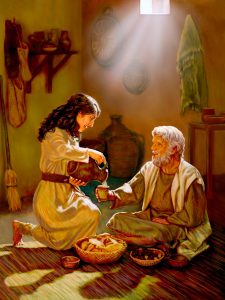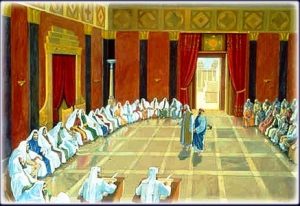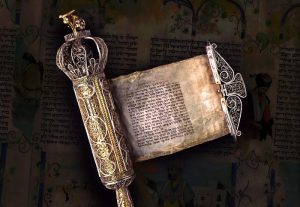Ki Sisa 2018: Who Wrote That Scroll?
by devadmin | March 1, 2018 8:47 pm
Who Wrote That Scroll?
Earlier this week, the heylige Oisvorfer got into a heated discussion with a chosid, one of the Satmar variety. He wanted to know why the Oisvorfer begins his weekly parsha reviews with a salutation to both men and women. “Don’t I know” he asked and stated empathically, and with some disgust, that women are not to learn too much Toirah. That their place is at home and or in the boudoir where they are to propagate and produce as many children as the RBSO will bless them with? Ober the Oisvorfer held ground and explained -or tried to- the importance of women and their role not just in the heylige Toirah, but also to the survival of the Yiddin throughout the millennia. In a week where we celebrate the courage of Esther Hamalka to share her jewels, if you chap, I thought we’d give a shout-out to other women of valor who played a role in this week’s heylige Parsha.
Last night and again earlier this morning, as the Migillah was being read – yes, we are obligated to read and hear it twice – the Oisvorfer was still not clear on one issue: who wrote it? Who was its real author? The emes is that this question was also asked of a few people -all different shades of orthodox- earlier this week. And to no one’s surprise, its authorship is not clear. And why should it be? Is there any one item, even one mitzvah, in our beautiful religion, and practice of it, that all agree on? Not!
 Let’s meet the candidates. Says the Migillah that its author was none other than Mordechai. Even Rashi agrees. After all does not the Migillah itself tell us (Ch 9: 20) that Mordechai was its author? It does? “Mordechai recorded these events and sent letters….” Case closed? No, why not? Because in the very same chapter (verse 29), we come across these words: “Then, Queen Esther, daughter of Avichayil, and Mordechai, wrote with full authority….” Was it a joint effort?
Let’s meet the candidates. Says the Migillah that its author was none other than Mordechai. Even Rashi agrees. After all does not the Migillah itself tell us (Ch 9: 20) that Mordechai was its author? It does? “Mordechai recorded these events and sent letters….” Case closed? No, why not? Because in the very same chapter (verse 29), we come across these words: “Then, Queen Esther, daughter of Avichayil, and Mordechai, wrote with full authority….” Was it a joint effort?
In any event, the heylige Gemora (Buba Basra) seems to tell a different story about its authorship. To whom does the heylige Gemorah attribute authorship? Nu, in the discussion detailing the authorship of each of the 24 seforim which make up Tanach (Scripture), it tells us the Migillah was written by the Anshei Keneses Hagidoila, the people of the great assembly. Who were these good people?
The Men of the Great Assembly — in Hebrew, Anshei Knesset HaGedolah — was a group of 120 Jewish personalities who assumed the reigns of Jewish leadership between 410 BCE and 310 BCE. In other words: they were active at the end of the Babylonian exile and during the early years of the 2nd Temple era.
Among them we count the last of the prophets Haggai, Zechariah and Malachi, as well as the sages Mordechai, (of the Purim story), Yehoshua, (the High Priest), Nechemia (the chief architect of rebuilding of Jerusalem), Shimon HaTzaddik (also a High Priest).
 Nu, efsher we can kler that both answers are true: Maybe Mordechai wrote it while he was also a member in good standing of the Anshei Keneses Hagidoila. That could work except for one thing. Seemingly the Great People of the Assembly were not yet busy assembling during this time.
Nu, efsher we can kler that both answers are true: Maybe Mordechai wrote it while he was also a member in good standing of the Anshei Keneses Hagidoila. That could work except for one thing. Seemingly the Great People of the Assembly were not yet busy assembling during this time.
Ober, another answer proffered is that the Migillah was efsher written twice. Once back in Shushan where the events described took place. Ober at that time, the Migillah was not yet canonized and was not yet part of the Tanach. Moreover, it may not have been required reading. Mordechai wrote that Migillah. Later, over in Israel, with the men of the Great Assembly fully organized and functioning, it is also possible that the Migillah was written again. Shoin. Case closed!?
What about Esther? Was she cut out of a writer’s credit? Say it’s not so. After all, wasn’t it through Esther and her valor, or her sacrifice of that valor, if you chap, to marry, live with and cohabit with the goyishe king, that the entire Purim miracle came about? It was! Was there an attempt to conceal her authorship davka because she, a nice Jewish girl, married a goy (gentile) mamish, and also while married to Mordechai (according to some)? Was Esther being double dipped, if you chap? On the other hand, let’s recall that the RBSO works in mysterious ways. Was it not the RBSO who arranged that Queen Vashti refuse to appear when the King called for her? Indeed it was! Was it not the RBSO who arranged for Achashveyroish to select Esther -even without makeup- as his replacement queen? It was! Was it not the RBSO who arranged for Mordechai to uncover the plot of Bikson and Seresh as they plotted to kill the King? It was! Nu, it was also part of the master plan for Esther to end up in the King’s palace and boudoir where she played a pivotal role in saving the Yiddin. Whether she authored, or co-authored the Migillah, ver veyst. She was and remains a heroine, our heroine. On the other hand, many a medrish tells us that though she did marry the King, she withheld sexual favors from him; her valor fully intact. Did she or did she not have relations with the good king? Ver veyst? One thing is zicher: his scepter she did touch as does the Migillah tell us. “….and Esther approached and touched the tip of the scepter.” Shoin!
As always, let’s not forget the RBSO, Master Puppeteer who was -behind the scenes- pulling all the strings. Case closed? Not exactly. Many taka say that the Migillah has a status of Halocho L’moishe Mi’Senai. Which means? In other words: the Migillah was written with Ruach Hakoidesh, a divine spirit. Exactly what that means, ver veyst, ober, if what Shmuel tells us in the heylige Gemora (Migillah: 7) is correct, it was the RBSO Himself who efsher put the words of the Migillah into the mouths and quills of whomever wound up putting quill to parchment. In other words: it, or parts of it, was divinely inspired. Shoin. Having trouble believing that the RBSO has such capabilities? Shame on you!
And taka, as you read this week’s Parsha of Ki Sisa, you’ll chap that the Veyber (married women) and those waiting (to get out or in), are taka Toirah worthy. Besides, weren’t they on Har Seeni to receive the heylige Toirah? Don’t they have a right to learn the Parsha? Didn’t they behave nicely while their husbands were slaves in Mitzrayim? Didn’t they bring food, massage and seduce their hard working men using special mirrors that we’ll discuss next week? And didn’t they miraculously give birth to 6 to 60 kinderlach (children) at a time? Don’t you remember anything, even the heylige Toirah you’ve been reading from the Oisvorfer Ruv weekly? Shreklich mamish (shocking)! Nu…let’s not get ahead of ourselves.
This is the Parsha where mamish but 40 days after the Yiddin proclaimed with unity those two holy words- Na’seh- Vinishma (we will do and then we will listen) – words that brought them the Toirah and a visit from the RBSO Himself to deliver the first of the Ten Commandments- the Yiddin got busy Naseh-ing (doing); unfortunately, it was the wrong thing! Instead of waiting for Moishe Rabaynu to come down from the mountain as he promised he would, they assumed he was dead and wanted a replacement. Instead of appointing Aharoin, Moishe’s older brother and zicher leadership worthy, they rampaged, killed Chur (efsher we’ll talk about him soon) and forced Aharoin to help them make an eygel (golden calf). Ober did the Yiddishe veyber cooperate with the plan? Were they co-conspirators? Avada nisht! In fact, quite the opposite is emes. The shlechte menthcin (bad guys) did approach the women seeking their help – for how does one make a golden calf? With gold avada! And who had gold and lots of it? The heylige veyber, that’s who. From 47th street, from Yirusha (inheritance), lovers and even husbands, ver veyst or maybe from the mitzrim as they left Egypt, but seemingly they had it. Some say the Munn was delivered gold encrusted, ver veyst. We are taught that approximately 3,000 people, grada not such a large amount considering how many left Mitzrayim, participated in the Eygel fiasco and the Medrish and others suggest that this entire clan was made up of the Erev Rav, not such good people who snuck out of Mitzrayim with the Yiddin.
 Nu, back to the women: and one has to think azoy: what were the men thinking when they approached the women asking for their gold? Have you ever seen a woman give up her jewelry? Her jewels, nu, that I’ve zicher seen, if you chap, ober nisht gold. In any event, in their zechus, the Oisvorfer decided that they should taka be zoiche to receive this Toirah weekly with a proper salutation. Shoin!
Nu, back to the women: and one has to think azoy: what were the men thinking when they approached the women asking for their gold? Have you ever seen a woman give up her jewelry? Her jewels, nu, that I’ve zicher seen, if you chap, ober nisht gold. In any event, in their zechus, the Oisvorfer decided that they should taka be zoiche to receive this Toirah weekly with a proper salutation. Shoin!
You shouldn’t think the heylige neshei chayil were stingy and refused to participate in other projects and says the Da’as Zekeinim that during the Eygel incident, the men took their wives’ jewelry by force, such chazerim (pigs). Shreklich mamish! The women had taka refused participation and donating to the misguided Eygel cause. However, not because they were stingy; they just chapped that something was wrong. Ober next week, in describing the donations to the Mishkon, a good and holy cause, we will taka learn that the women wanted to participate with donations, including their jewelry and the special mirrors they used in the fields of Mitzrayim. Ober chap nisht, we’ll cover all that next week. This week, we’ll keep the Toirah short. Moreover, these same heylige veyber (holy women) stepped up and we’ll learn that according to the Medrish in relation to the Mishkon, there were, in fact, many men who were reluctant to give their money, while the women were universally enthusiastic.
As our parsha opens, Moishe Rabaynu is getting bookkeeping and accounting lessons; yet another Toirah inspired Jewish profession. This education will come in handy in two weeks when an audit will be conducted of all the monies and materials raised for the Mishkan project. The RBSO is giving specific instructions about the way to count the Yiddin. Out is the standard One… two… three… four… as adopted years later by the AICPA; that’s good for counting goyim, your own money, and the number of friends you can count on when you need them. To count the Yiddin, Moishe is told azoy: Every male Jew, age 20 and above must line up and hand Moishe a silver coin weighing 1/2 a Shekel. Instead of counting the people, the coins will be counted, each representing one person. Mistama (likely), there were even more men but as we well know when it comes to giving a shekel or even a machtzis (1/2), not all Yiddin like to be counted. Also, a few threw in a quarter and some even less. Some say that one or two zicher threw in a check and took out the cash; nu, what can you do. We can speculate that some Yiddin decided to sit out the count altogether if it wasn’t free. Ober, poor Moishe didn’t know what this coin looked like and let’s keep in mind that it’s 3000+ years before Google images. What to do? Says Rashi quoting the Medrish Tanchuma: The RBSO concluded the class with a fiery visual aid of a ½ shekel coin so that Moishe will know what to look for. What happened to these coins once the count was over? What really happened to the money? Ver Veyst. Stay tuned for parshas Pikudai where a few accused Moishe of pocketing a few shekels. Nu, it wouldn’t be the first time that building campaign money suddenly disappeared, if you chap. Zicher not the last.
Speaking of counting the Yiddin, efsher you remember that way back in yeshiva, the rebbe, when taking attendance or stam a count to see who ran away (after his advances), wouldn’t stam yell out 1-2-3-4. Instead we were counted using the words of a long popular song that makes an appearance each year at Simchas Toirah. The words come from the song known as Hoisheoh, es, Amehcho which grada has but 10 words. And why is this being mentioned? Because as we stated just above, the instruction Moishe was given was not to count the Yiddin by counting people. Instead, his instructions were to take a half shekel coin from each Yid and then count the coins, so that “there will not be a plague among the Jews as they are counted” (Shemois 30:12). And believe it or not, this is the source mamish for the well-known law that we can’t count Yiddin by numbers. Instead, we count them through an object – such as the ½ shekel coin mentioned above. Later on when King Shaul ordered a count of his soldiers, he asked each one of them to bring a kid goat as better described in the Novee (Prophet) (Shmuel I Chapter 15). Later on Dovid Hamelech (King David) did a manual count with disastrous results, many died. Avada you should pick up the Novee, dust it off properly and then read the story, also in Shmuel II, Chapter 24 which described the giferliche plague that ensued following the count. Counting can be dangerous and it’s efsher no wonder that the heylige Toirah allows the Yiddin to save themselves by contributing the 1/2 shekel. It’s a life saver.
A gittin Shabbis and a freylichen Purim!
The Heylige Oisvorfer Ruv
Yitz Grossman
Source URL: https://oisvorfer.com/ki-sisa-2018-who-wrote-that-scroll/
